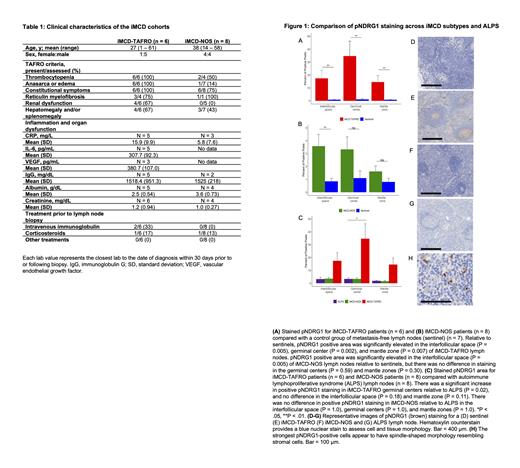Abstract
Idiopathic multicentric Castleman disease (iMCD) is a rare and life-threatening disorder involving polyclonal lymphoproliferation and organ dysfunction due to excessive cytokine production, including interleukin-6 (IL-6). Anti-IL-6 therapy is recommended first-line and effective in 34-45% of patients. mTOR, which functions through mTORC1 and mTORC2, is a recently-discovered therapeutic target. The mTOR inhibitor sirolimus, which preferentially inhibits mTORC1, has led to sustained remission in a small cohort of anti-IL-6 refractory iMCD patients with thrombocytopenia, anasarca, fever, renal dysfunction, and organomegaly (TAFRO). However, sirolimus has not shown uniform effect, potentially due to its limited mTORC2 inhibition. To investigate mTORC2 activation in iMCD, we quantified the mTORC2 effector protein pNDRG1 by immunohistochemistry of lymph node tissue from iMCD-TAFRO (N=6) patients and iMCD patients not meeting TAFRO criteria (iMCD-NOS; N=8) (Table 1) as well as autoimmune lymphoproliferative syndrome (ALPS) (N=6), Hodgkin lymphoma (positive controls, N=8), and metastasis-free sentinel lymph nodes (normal controls, N=8).
In iMCD-TAFRO, pNDRG1 expression was elevated in the interfollicular space (IF) (P=0.005), germinal centers (GC) (P=0.002), and mantle zones (MZ) (P=0.007) relative to normal controls (Figure 1A). pNDRG1 staining was increased in the IF (P=0.005) of iMCD-NOS relative to normal controls and there was no difference in the GC (P=0.59) and the MZ (P=0.30) (Figure 1B). Next, we compared pNDRG1 expression in iMCD-TAFRO and iMCD-NOS to ALPS, an mTOR-driven, sirolimus-responsive lymphoproliferative disorder.Our results revealed increased pNDRG1 staining in iMCD-TAFRO GC relative to ALPS (P=0.02) (Figure 1C). There were no differences in pNDRG1 expression between iMCD-NOS and ALPS in any region (Figure 1C). Notably, the strongly positive pNDRG1 cells had spindle-shaped morphology resembling stromal cells (Figure 1H).
These results suggest increased mTORC2 activity in iMCD and that dual mTORC1/mTORC2 inhibitors may be a rational therapeutic approach for anti-IL-6 treatment refractory patients. Further studies are needed to confirm this finding, uncover cell types showing increased mTORC2 expression, and investigate therapeutic approaches.
Fajgenbaum: EUSA Pharma: Research Funding; N/A: Other: Holds pending provisional patents for 'Methods of treating idiopathic multicentric Castleman disease with JAK1/2 inhibition' and 'Discovery and validation of a novel subgroup and therapeutic target in idiopathic multicentric Castleman disease'; Pfizer: Other: Study drug for clinical trial of sirolimus.


This feature is available to Subscribers Only
Sign In or Create an Account Close Modal